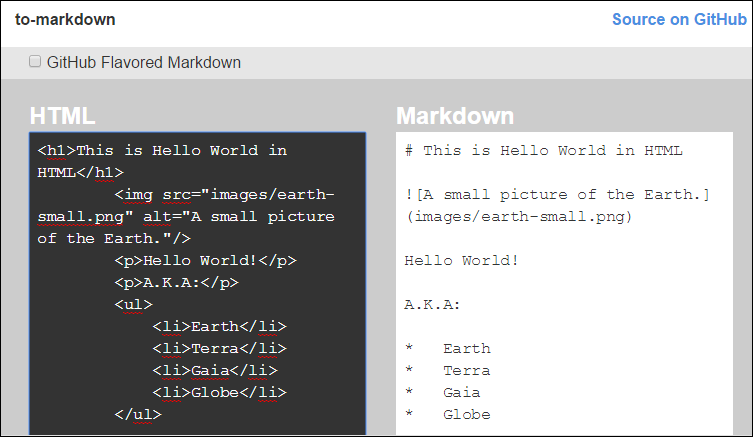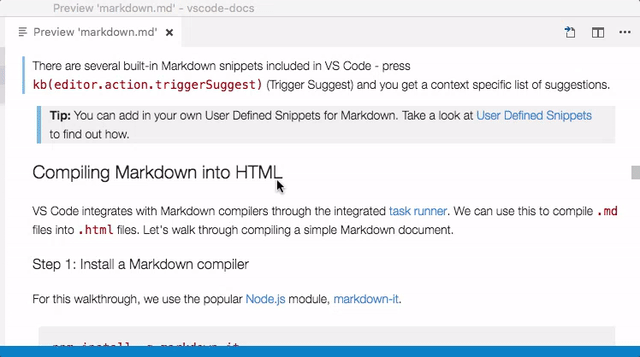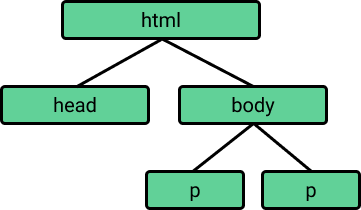- Mar 03, 2021 Markdown is a way of writing a formatted text on the web. This article discusses how an HTML text can be converted to Markdown. We can easily convert HTML to markdown using markdownify package. So let’s see how to download markdownify package and convert our HTML to markdown in python. Installation: This module does not come in-built with Python.
- Jul 21, 2020 from markdownify import markdownify file = open('./hello-world.html', 'r').read html = markdownify(file, headingstyle='ATX') print(html) ## ## Hello, World! As you can see, converting HTML to Markdown in Python is very simple. With the excellent Markdownify package, the conversion process only requires a few lines of code.
- Markdown has very little to do with python testing. But I need a project to test, so I'm writing my own Markdown script. This is a brief introduction to.
- Html Table To Markdown Python
- Html To Markdown Python
- Convert Html To Markdown Python
- Parse Markdown To Html Python
- Python Markdown To Html With Css
- Html To Slack Markdown Python
Storing user-created articles in your database as Markdown Syntax instead of the final rendered HTML solves so many problems. It’s not only more secure and helps you prevent XSS injections into your content, but it also makes it much more flexible to change the rendered version of the content at a later stage in the lifetime of your application.
A Computer Science portal for geeks. It contains well written, well thought and well explained computer science and programming articles, quizzes and practice/competitive programming/company.
This article that you’re reading right now has been written using Markdown Syntax. That’s how it’s being stored in the database, and then whenever you visit this page where the article is stored, Python code converts it into HTML and then add custom features such as classes, ids or other HTML attributes to selected elements, and then serves it to your browser.
This means that the creation of the content is strictly separated and decoupled from how it’s being rendered in its final form. Separating the logic related to the content in this manner brings many different benefits compared to creating the content using a WYSIWYG HTML Editor.
What’s Wrong with WYSIWYG HTML Editors?
For example, let’s say that we use a WYSIWYG HTML Editor to allow users to create their content. We then store this HTML in our database and serve it straight from the database whenever a user visits the page of the article. This setup means that we have to be concerned about the following things:
- Javascript injections into the content.
- A non-standardized look of articles and content.
- How the stored content will adapt to future changes to our design.
- Invalid HTML Markup.
What if we later realize that we want to modify the HTML of our articles? For example, let’s say that we want all <table> elements to have a certain class, or we want all links to be rel='nofollow', or we want all headlines to have an id attribute so that we can link to them?
Html Table To Markdown Python
We already stored the HTML and we are expecting to be able to use it straight from the database, so any kind of change or feature that we want to add that is related to our content would require us to write scripts or queries that updates the stored HTML from previous articles.
It quite quickly becomes tiresome and prone to mistakes and bugs, and it might lead to the developer avoiding updating older content, which in turn leads to our website having non-standardized formatting of the articles.
How to Use Markdown Syntax with Python
For most things you can think of, there is a python library available for it. So is naturally also the case for Markdown. There is a library called Python-Markdown that can easily be installed with pip using the following command:
Get weekly notifications of the latest blog posts with tips and learnings of how to become a better programmer.
No spam, no advertising, just content.
The library offers multiple useful methods and tools for when it comes to working with strings that are formatted using Markdown Syntax. For example, we can easily turn Markdown into HTML with a single method call.

The Markdown library also comes with the ability to add different types of extensions that modify the behavior or the way that markdown parse the Markdown Syntax. For example, you can modify how lists are parsed using the Sane Lists extension, or you can add code highlights of any <code> block using the CodeHilite extension.
Add Code Highlights using the CodeHilite Markdown Extension
So let’s illustrate how you can activate an extension for the markdown library to modify the way it generates HTML out of your Markdown Syntax. In this case, we will add code highlights to <code> blocks that match the programming language that is being used.
If we don’t install any extension, code blocks are generated in the following manner:
Gets rendered as:
So technically, it works. It does understand that it is a code block and it wraps it as a <code> element. But what if we want to add highlights so that different syntax is colored in different colors, to improve the readability for the visitors that come to read our articles?

We might want to wrap the print( part with a <span> to make it red, and then wrap the string within with a <span> that turn it into a green color. It would be a mess to attempt to do all of this by hand, and this is exactly the kind of things that the “CodeHilite” extension does for us.
To be able to enable the extension, we first have to install its dependency Pygments. Pygments is a popular syntax highlighter written in python and it is what takes care of the bulk of the work that the CodeHilite extension does. We can install it using pip.
Html To Markdown Python
To enable the CodeHilite extension, all we have to do is to add the extensions kwarg to our markdown() call that turn our Markdown Syntax into HTML.

This then wraps our code into the following HTML syntax:
But obviously, just wrapping things in <span> elements doesn’t do much. What does class='k' or class='p' even mean? Where are those styles defined? Well for this we have to import a CSS stylesheet that defines all of the style rules required.
To do this, we can either generate our own styles which are documented in the CodeHilite Documentation by using the following command:
The command will generate a styles.css file for us that is populated with style rules that expect the code highlighting to be wrapped in a container with the .codehilite class.
The other alternative is to check out GitHub user richleland who have created multiple presets that follow common IDE styles that we can use.
How to Modify Markdown’s Generated HTML with BeautifulSoup
Convert Html To Markdown Python
So now we have installed the markdown library and we’ve learned how to add extensions that modify some of the generated HTML. But what if we also want to add our own custom attribute to different HTML elements?
For example, right now a user can create an HTML link using the Markdown Syntax. By default the HTML element is just a pure <a> element. But what if we want to add rel='nofollow' or target='_blank' to each link?
Well, we could create a Markdown Extension to achieve this, but we can also use something like BeautifulSoup4 to parse and modify the HTML that has been generated before we serve it to the user. This gives us a lot of choices and possibilities to add anything we’d like to our final output.
Install BeautifulSoup4
BeautifulSoup4 is a super popular library that gives the developer an amazing set of tools to easily parse and modify HTML. It’s both being used by web crawlers to understand contents of websites, but it can also be used by us to read and modify HTML elements on the fly before it’s served to our users.
We can install BeautifulSoup4 using pip.
We are then ready to use it in our code by importing it as:
Use BeautifulSoup to Modify HTML In-Place
So let’s take the example that we used in the section above regarding modifying <a> elements and add things such as target='_blank' or rel='nofollow' attributes to it.
Here’s an example of how this could be achieved:
This will then do the following things:
- Use the
markdownlibrary to turn our Markdown Syntax to HTML. - Use the
codehiliteextension to add Code highlights to any code blocks. - Turn the HTML into a
BeautifulSoupobject that allows us to easily search and iterate through it. - Add
relandtargetattributes to all HTML<a>elements. This all happens in-place. - Finally turn the
BeautifulSoupobject into HTML and return it.
It’s easy to imagine a lot of other things you can achieve with this combination of tools such as:
- Make all images responsive by adding
img-fluidBoostrap classes to them. - Add title and alt tags to images and links to improve On-Page SEO.
- Treat internal links and external links differently and set different
relvalues depending on where they link. - Add
idto elements so that they can be anchored and linked to.
Benefits and Conclusion of Markdown Syntax over HTML WYSIWYG
This style of working and storing content is the way that this website stores and manage the content of all articles. It has many different benefits over the traditional WYSIWYG method where you store the final HTML ready to be served.
- We have more control of the HTML that we output since we process it before rendering it. It’s not completely in the hands of the users.
- Users can focus more on the content they produce, than how it is supposed to look like in its final form.
- Since we never allow users to input raw HTML, we can treat it all as unsafe and completely prevent things like Javascript injections.
- All of our articles will always look the same and follow the same style guides. We will never have an article that has a different font size on one of their headlines than another.
Some people argue that Markdown Syntax is more difficult to learn than using WYSIWYG HTML Editors. This is simply not true. First of all, you can use editors for Markdown Syntax as well that allow you to have shortcuts to do things like bold text, add links or upload images.
Second of all, Markdown Syntax is no doubt simpler than HTML and XML.
Get weekly notifications of the latest blog posts with tips and learnings of how to become a better programmer.
No spam, no advertising, just content.
HTML to Markdown? Isn't Markdown used as a convienient syntax to write and read text for later display in a web browser as HTML (without having to deal with messy HTML tags). Why go the other way? Maybe you need to convert existing HTML pages into the now widely used and convienient Markdown (or CommonMark) format. Hopefully Markdown is now your main working format and you need to convert old content to it. You may need to work with HTML files sent to you, or you have documents in propriety formats that cannot be directly saved in Markdown format (e.g. Microsoft Word files). Finally you may grab nuggets of useful information from the web and want to add them to your Markdown documents, preserving some formatting. Whatever the reason here's some options to convert HTML to Markdown, from online tools to editing the raw HTML.
A Basic HTML Page for Testing
Parse Markdown To Html Python
If you want to try some of the following HTML to Markdown conversion options you may need a basic HTML page to test them. There is a simple Hello World! HTML page here. In most browsers bring up the context menu (usually a right click) and select View source or View page source (it can also be accessed via the browser's menu options).

You can now select all or any part of the HTML code and copy it. Usually everything between the body tags is the most interesting. (Ctrl-A then Ctrl-C on Windows will highlight then copy all the HTML.)
Use an Online HTML to Markdown Converter
There is a JavaScript file that will do HTML to Markdown conversion on GitHub. The to-markdown project by Dom Christie has a page that accepts HTML and shows Markdown:
The converted Markdown can be copied and pasted into your documents. Don't forget to save any images or other media from the web that are referenced by the Markdown if you need them. (In most browsers use the context menu to select the option to save an image.)
Python Markdown To Html With Css
Online HTML to Markdown Converter Via URL
The website Heck Yes Markdown - www.heckyesmarkdown.com uses a PHP HTML to Markdown converter called Markdownify. It will attempt to convert the relevant text at a given URL into Markdown.
Again the Markdown can be copied ready for pasting into your documents and any media files downloaded.
Convert HTML to Markdown Online Via a File Upload
Html To Slack Markdown Python
The online Markdown editor Markable.in supports uploading HTML files. Once uploaded the Markdown is available for further editing and the HTML is shown alongside.
Edit the HTML to Convert it to Markdown
You can of course simply edit the HTML to convert it to Markdown. Any text editor will do, e.g. Notepad in Windows or Notepad++. Use the editors search and replace functionality to speed up the manual conversion process. If the text editor supports regular expression search and replace some creative thinking can be used.
Additional Resources
- Html2text is a Python script that will convert HTML files to Markdown text files.
- Pandoc is a universal document converter available for most platforms and supports conversion of multiple file types, including HTML to Markdown and Markdown to other formats.
- Writage is a Microsoft Word plug-in that uses Pandoc to save to a Markdown format text file.
